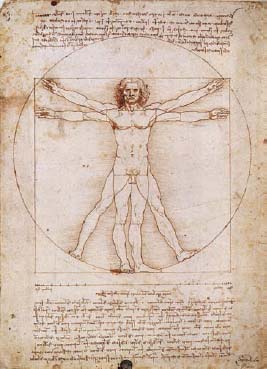The Early Modern World, C. 1300–1600High Renaissance in Italy |
What is The Vitruvian Man? |
The Vitruvian Man is a drawing by Leonardo da Vinci of a visual concept described by the Roman architect Vitruvius in the first century B.C.E. in his work On Architecture. As an architect, Vitruvius was interested in harmony, symmetry, and balance—all qualities that were highly valued by Classically minded artists and architects during the Renaissance, including Leonardo da Vinci. He explained his belief that supremely beautiful and unified architecture could be created using the proportions of the human body as a guide.
As Vitruvius never provided any illustrations of his own, many different artists attempted to visually depict the concept. Da Vinci’s drawing is likely the most familiar version. An idealized human male is depicted standing tall within a circle and a square. The figure’s outstretched arms are shown in duplicate; one set reaches the point at which the circle meets the square, while the second set runs horizontally, reaching the vertical sides of the square. The figure also has two pairs of legs, one straight, and one outstretched, mirroring the position of the arms. The drawing highlights Leonardo da Vinci’s mathematical creativity and emphasizes the Renaissance preference for geometric balance.

Leonardo da Vinci’s representation of the classical Vitruvian Man emphasizes balance and symmetry, both important values for Renaissance artists.
